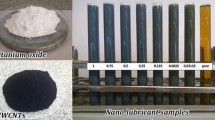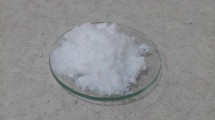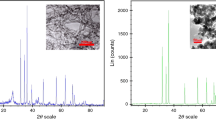Abstract
In this study, the viscosity of SAE 50 engine oil containing MWCNT-ZnO nanoparticles was investigated experimentally. For this purpose, volume fractions (VFs) of 0.0625–1% of nano-oil were prepared and their dynamic viscosity was measured at different temperatures of 25–50 °C with changing shear rate (SR) and its rheological behavior was studied. The investigations showed the dependency of viscosity to SR variation, which is a sign for non-Newtonian behavior of nano-fluid (NF). The results clearly showed that pure oil and nano-oil behave non-Newtonian and behave similar to non-Newtonian shear-thinning fluids. To prevent spending extra money in future studies a new mathematical based correlation is proposed with the accuracy of R2 = 0.9984. By doing a comparisons between predicted resutls by the correlation and experimental results a proper accuracy in the mentioned temperature and concentration ranges was obtained.
Graphic abstract








Similar content being viewed by others
Abbreviations
- \(\dot{\gamma }\left( {s^{ - 1} } \right)\) :
-
Shear rate
- Τ (Pa):
-
Shear stress
- T (℃):
-
Temperature
- φ (%):
-
Volume fraction
- μ (m2 s−1):
-
Viscosity
- ρ(kg m−3):
-
Density of the fluid
- SR:
-
Shear rate
- NFs:
-
Nano-fluids
- BFs:
-
Base fluids
- NPs:
-
Nanoparticles
- NF:
-
Nano-fluid
- VF:
-
Volume fraction
- R 2 :
-
Coefficient of determination
- SS:
-
Shear stress
References
Choi SUS. Enhancing thermal conductivity of fluids with nanoparticles. ASME-Publications-Fed. 1995;231:99–106.
Hojjat M, et al. Turbulent forced convection heat transfer of non-Newtonian nanofluids. Exp Therm Fluid Sci. 2011;35(7):1351–6.
Yousefi F, Hajir K, Mohammad MP. Modeling viscosity of nanofluids using diffusional neural networks. J Mol Liq. 2012;175:85–90.
Anoop K, Cox J, Sadr R. Thermal evaluation of nanofluids in heat exchangers. Int Commun Heat Mass Transfer. 2013;49:5–9.
Hemmat Esfe M, et al. Numerical simulation of natural convection around an obstacle placed in an enclosure filled with different types of nanofluids. Heat Transf Res. 2014;45(3):150.
Hemmat Esfe M, et al. Using artificial neural network to predict thermal conductivity of ethylene glycol with alumina nanoparticle. J Therm Anal Calorim. 2016;126(2):643–8.
Ghanbarpour M, Khodabandeh R. Entropy generation analysis of cylindrical heat pipe using nanofluid. Thermochim Acta. 2015;610:37–46.
Hemmat Esfe M, et al. Mixed-convection flow and heat transfer in an inclined cavity equipped to a hot obstacle using nanofluids considering temperature-dependent properties. Int J Heat Mass Transf. 2015;85:656–66.
Hemmat Esfe M, Seyfolah S. Turbulent forced convection heat transfer and thermophysical properties of Mgo–water nanofluid with consideration of different nanoparticles diameter, an empirical study. J Therm Anal Calorim. 2015;119(2):1205–13.
Hemmat Esfe M, et al. An experimental study on viscosity of alumina-engine oil: effects of temperature and nanoparticles concentration. Int Commun Heat Mass Transf. 2016;76:202–8.
Esfe MH et al. Designing an artificial neural network to predict dynamic viscosity of aqueous nanofluid of TiO2 using experimental data. Int Commun Heat Mass Transf. 2016;75:192–196.
Esfe MH, Wongwises S, Naderi A, Asadi A, Safaei MR, Rostamian H, Karimipour A. Thermal conductivity of Cu/TiO2–water/EG hybrid nanofluid: Experimental data and modeling using artificial neural network and correlation. Int Commun Heat Mass Transf. 2015;66:100–104.
Esfe MH, Arani AAA, Rezaie M, Yan WM, Karimipour A. Experimental determination of thermal conductivity and dynamic viscosity of Ag–MgO/water hybrid nanofluid. Int Commun Heat Mass Transf. 2015;66:189–195.
Esfe MH, Yan WM, Akbari M, Karimipour A, Hassani M. Experimental study on thermal conductivity of DWCNT-ZnO/water-EG nanofluids. Int Commun Heat Mass Transf. 2015;68:248–251.
Esfe MH, Esfandeh S, Arani AAA. Proposing a modified engine oil to reduce cold engine start damages and increase safety in high temperature operating conditions. Powder Tech 2019;355:251–263.
Esfe MH, Arani AAA, Esfandeh S, Afrand M. Proposing new hybrid nano-engine oil for lubrication of internal combustion engines: Preventing cold start engine damages and saving energy. Energy 2019;70:228–238.
Esfe MH, Arani AAA, Esfandeh S. Improving engine oil lubrication in light-duty vehicles by using of dispersing MWCNT and ZnO nanoparticles in 5W50 as viscosity index improvers (VII). Appl Therm Eng 2018;143:493–506.
Hafiz Ali, Hybrid Nanofluids for Convection Heat Transfer, 2020, eBook ISBN: 9780128192818
Esfe MH, Esfandeh S (2020) 3D numerical simulation of the enhanced oil recovery process using nanoscale colloidal solution flooding. J Mol Liquids 2020;301:112094.
Esfe MH, Hosseinizadeh E, Esfandeh S. Flooding numerical simulation of heterogeneous oil reservoir using different nanoscale colloidal solutions. J Mol Liquids 2020;302:111972.
Nasiri A, et al. Effect of CNT structures on thermal conductivity and stability of nanofluid. Int J Heat Mass Transf. 2012;55(5):1529–35.
Iranidokht V, et al. Thermal conductivity of mixed nanofluids under controlled pH conditions. Int J Therm Sci. 2013;74:63–71.
Hajjar Z, Ali MR, Ahmad G. Enhanced thermal conductivities of graphene oxide nanofluids. Int Commun Heat Mass Transf. 2014;57:128–31.
Esfe MH, Rostamian, SH. Rheological behavior characteristics of MWCNT-TiO2/EG (40%–60%) hybrid nanofluid affected by temperature, concentration, and shear rate: An experimental and statistical study and a neural network simulating. Phy A: Stat Mech Appl. 2020;124061.
Hemmat Esfe M, et al. Applicability of artificial neural network and nonlinear regression to predict thermal conductivity modeling of Al2O3–water nanofluids using experimental data. Int Commun Heat Mass Transf. 2015;66:246–9.
Hemmat Esfe M, et al. Experimental investigation of thermal conductivity of CNTs-Al2O3/water: a statistical approach. Int Commun Heat Mass Transf. 2015;69:29–33.
Hemmat Esfe M, et al. Modeling and estimation of thermal conductivity of MgO–water/EG (60: 40) by artificial neural network and correlation. Int Commun Heat Mass Transf. 2015;68:98–103.
Ahmadloo E, Azizi S. Prediction of thermal conductivity of various nanofluids using artificial neural network. Int Commun Heat Mass Transf. 2016;74:69–75.
Hemmat Esfe M, et al. Estimation of thermal conductivity of Al2O3/water (40%)–ethylene glycol (60%) by artificial neural network and correlation using experimental data. Int Commun Heat Mass Transf. 2016;74:125–8.
Nadooshan AA. An experimental correlation approach for predicting thermal conductivity of water-EG based nanofluids of zinc oxide. Physica E. 2017;87:15–9.
Godson L, et al. Experimental investigation on the thermal conductivity and viscosity of silver-deionized water nanofluid. Exp Heat Transf. 2010;23(4):317–32.
Abareshi M, et al. Fabrication, characterization, and measurement of viscosity of α-Fe2O3-glycerol nanofluids. J Mol Liq. 2011;163(1):27–32.
Duan F, Ting FW, Alexandru C. Dynamic viscosity measurement in non-Newtonian graphite nanofluids. Nanoscale Res Lett. 2012;7(1):360.
Hemmat Esfe M, Seyfolah S, Amin A. An empirical investigation on the dynamic viscosity of Mg (OH)2–ethylene glycol in different solid concentrations and proposing new correlation based on experimental data. Int J Nat Eng Sci. 2014;8(3):29–34.
Hemmat Esfe M, Seyfolah S, Mostafa M. Experimental studies on the convective heat transfer performance and thermophysical properties of MgO–water nanofluid under turbulent flow. Exp Therm Fluid Sci. 2014;52:68–78.
Hemmat Esfe M, et al. Thermophysical properties, heat transfer and pressure drop of COOH-functionalized multi walled carbon nanotubes/water nanofluids. Int Commun Heat Mass Transf. 2014;58:176–83.
Hemmat Esfe M, et al. Heat transfer characteristics and pressure drop of COOH-functionalized DWCNTs/water nanofluid in turbulent flow at low concentrations. Int J Heat Mass Transf. 2014;73:186–94.
Hamid KA, et al. Investigation of Al2O3 nanofluid viscosity for different water/EG mixture based. Energy Procedia. 2015;79:354–9.
Abdolbaqi M, et al. An experimental determination of thermal conductivity and viscosity of BioGlycol/water based TiO2 nanofluids. Int Commun Heat Mass Transf. 2016;77:22–32.
Sharifpur M, Saheed AA, Josua PM. Experimental investigation and model development for effective viscosity of Al2O3–glycerol nanofluids by using dimensional analysis and GMDH-NN methods. Int Commun Heat Mass Transf. 2015;68:208–19.
Bahrami M, et al. An experimental study on rheological behavior of hybrid nanofluids made of iron and copper oxide in a binary mixture of water and ethylene glycol: non-Newtonian behavior. Exp Therm Fluid Sci. 2016;79:231–7.
Nabil MF, et al. An experimental study on the thermal conductivity and dynamic viscosity of TiO2-SiO2 nanofluids in water: ethylene glycol mixture. Int Commun Heat Mass Transf. 2017;86:181–9.
Arslan O, Yetik O. ANN modeling of an ORC-binary geothermal power plant: simav case study. Energy Sources Part A Recovery Util Environ Effects. 2014;36(4):418–28.
Motahar S, Bagheri-Esfeh H. Artificial neural network based assessment of grid-connected photovoltaic thermal systems in heating dominated regions of Iran. Sustain Energy Technol Assess. 2020;39:100694.
Aminian A. Predicting the effective viscosity of nanofluids for the augmentation of heat transfer in the process industries. J Mol Liq. 2017;229:300–8.
Sarkar J, Ghosh P, Adil A. A review on hybrid nanofluids: recent research, development and applications. Renew Sustain Energy Rev. 2010;43:164–77.
Fereidoon A, Saedodin S, Hemmat Esfe M, Noroozi MJ. Evaluation of mixed convection in inclined square lid-driven cavity filled with Al2O3/water nano-fluid. Eng Appl Comput Fluid Mech. 2013;7:155–65.
Baratpour M, Karimipour A, Afrand M, Wongwises SJICIH, Transfer M. Effects of temperature and concentration on the viscosity of nanofluids made of single-wall carbon nanotubes in ethylene glycol. Eng Appl Comput Fluid Mech. 2016;74:108–13.
Hemmat Esfe M, Karimpour R, Arani AAA, Shahram J. Experimental investigation on non-Newtonian behavior of Al 2 O 3-MWCNT/5W50 hybrid nano-lubricant affected by alterations of temperature, concentration and shear rate for engine applications. Int Commun Heat Mass Transf. 2017;82:97–102.
Motahari K, Mohammad AM, Mojtaba M. Experimental investigation and development of new correlation for influences of temperature and concentration on dynamic viscosity of MWCNT-SiO2 (20–80)/20W50 hybrid nano-lubricant. Chin J Chem Eng. 2017;10:150.
Hemmat Esfe M, Afrand M, Rostamian SH, Toghraie D. Examination of rheological behavior of MWCNTs/ZnO-SAE40 hybrid nano-lubricants under various temperatures and solid volume fractions. Exp Thermal Fluid Sci. 2017;80:384–90.
Zareh-Desari B, Davoodi B. Assessing the lubrication performance of vegetable oil-based nano-lubricants for environmentally conscious metal forming processes. J Clean Prod. 2016;135:1198–209.
Hemmat Esfe M, Mohammad RS. Experimental investigation of switchable behavior of CuO-MWCNT (85–15%)/10W-40 hybrid nano-lubricants for applications in internal combustion engines. J Mol Liq. 2017;242:326–35.
Hemmat Esfe M, et al. Experimental investigation, model development and sensitivity analysis of rheological behavior of ZnO/10W40 nano-lubricants for automotive applications. Physica E. 2017;90:194–203.
Wu H, et al. Analysis of TiO2 nano-additive water-based lubricants in hot rolling of microalloyed steel.”. J Manuf Process. 2017;27:26–36.
Nadooshan AA, Mohammad HE, Masoud A. Evaluation of rheological behavior of 10W40 lubricant containing hybrid nano-material by measuring dynamic viscosity. Physica E. 2017;59:965.
Hemmat Esfe M, Hossein R. Non-Newtonian power-law behavior of TiO2/SAE 50 nano-lubricant: an experimental report and new correlation. J Mol Liq. 2017;232:219–25.
Acar MS, Erbas O, Arslan O. The performance of vapor compression cooling system aided Ranque-Hilsch vortex tube. Therm Sci. 2019;23(2B):1189–201.
Senturk AM, Arslan O. Performance analysis of a new hybrid cooling-drying system. Environ Progress Sustain Energy. 2018;37(5):1808–28.
Author information
Authors and Affiliations
Corresponding author
Additional information
Publisher's Note
Springer Nature remains neutral with regard to jurisdictional claims in published maps and institutional affiliations.
Rights and permissions
About this article
Cite this article
Hemmat Esfe, M. An experimental report and new correlation for estimating the dynamic viscosity of MWCNT(50)-ZnO(50)/SAE 50 as nano-lubricant. J Therm Anal Calorim 143, 1107–1117 (2021). https://doi.org/10.1007/s10973-020-09731-7
Received:
Accepted:
Published:
Issue Date:
DOI: https://doi.org/10.1007/s10973-020-09731-7




